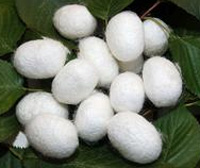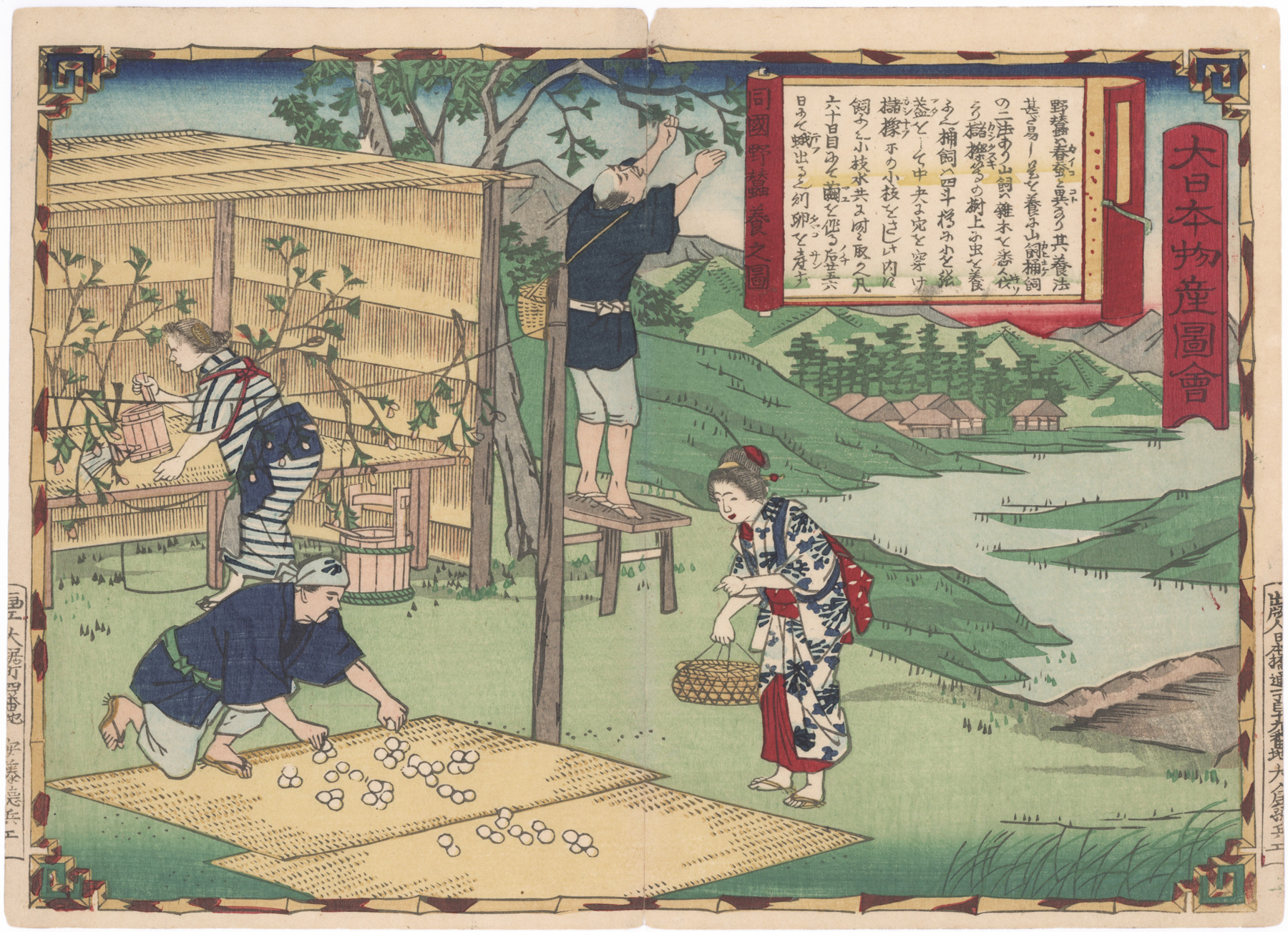About This Print
One of 118 prints in the series Dai Nippon Bussan Zue (Products of Greater Japan), issued in August 1877 to coincide with the opening of Japan’s first National Industrial Exposition (Naikoku Kangyō Hakurankai) held in Tokyo’s Ueno Park, depicting the tending of mulberry trees and silkworm cocoons. When this print was issued in 1877 silk was Japan's leading export and by 1909 Japan surpassed China as the world's number one silk producer.1

Silkworm cocoons
In keeping with the importance of sericulture to Japan's economy and industrialization, seven prints in the series are devoted to it. The Exposition was essentially "an industrial promotion opportunity providing a meeting place for Western technologies and their Japanese counterparts."2 "Silk production was the first example of an industry in which European producers deliberately sought out Japanese know-how" and "the source of Japan's first export technology."3
The six prints in the series depicting silkworm culture are:
Silkworm Culture in Hida Province (figure 2) 飛騨国 養蚕之図 二
Silkworm Culture in Shimotsuke Province (figure 3) 下野国 養蠶國 三
Silkworm Culture in Rikuzen Province (figure 5) 陸前国 養蠶図 五
Silkworm Culture in Rikuchū Province (figure 6) 陸中国 養蚕之図 六
Tajima Province (但馬国 Tajima no kuni) was an old province of Japan in the area that is today northern Hyōgo Prefecture. It was sometimes called Tanshū (但州). Tajima bordered on Harima, Inaba, Tamba, and Tango provinces. Tajima is the birthplace of Kobe beef, known locally as Tajima beef. Also well-known are its many onsens, beaches, and small ski resorts. Its main industries are forestry, fishing, farming, and tourism.4
Multiple Editions (Variant Printings)
At least three variant printings (editions) were made of this series. Each variant printing uses a different colored cartouche containing the series' title, either red, green or rainbow-colored. Different colored borders were also used and variances in the use of colors and shading are present in the three editions.2 Website National Diet Library https://www.ndl.go.jp/exposition/e/s1/naikoku1.html
3 "Sericulture and the Origins of Japanese Industrialization", Tessa Morris-Suzuki, appearing JSTOR, Vol. 33, No.1, January 1992, p. 1-2-103; p. 121.
4 Wikipedia https://en.wikipedia.org/wiki/Tajima_ProvincePrint Details
| IHL Catalog | #1497 |
| Title or Description | Cultivating Wild Silkworms in Tajima Province 同国 [但馬国] 野蚕(蠶)養之図 dōkoku [Tajima no kuni] yasan yō no zu |
| Series | Dai Nippon Bussan Zue 大日本物産図会 (Products of Greater Japan) |
| Artist | Utagawa Hiroshige III (1842–1894) |
| Signature |  |
| Seal | none |
| Publication Date | 1877 (Meiji 10) |
| Publisher |  appearing in right margin (almost completely trimmed from this print) Full cartouche reads 出版人 日本橋通一丁目十九番地 大倉孫兵衛 (Publisher, Nihobashi-dōri Itchōme 19-banchi, Ōkura Magobei) |
| Impression | excellent |
| Colors | excellent |
| Condition | fair - vertical centerfold reinforced by tape on verso; paper separation top half of centerfold |
| Genre | nishiki-e; kaika-e |
| Miscellaneous | |
| Format | chuban |
| H x W Paper | 6 3/4 x 9 1/4 in. (17.1 x 23.5 cm) |
| H x W Image | 6 3/8 x 9 in. (16.2 x 22.9 cm) |
| Literature | |
| Collections This Print | Waseda University Library Archives 01_04265_0001 |
3/26/2020


